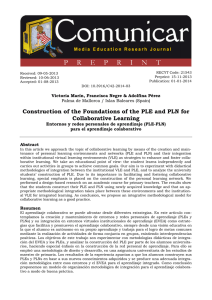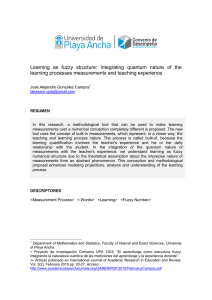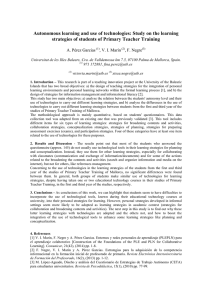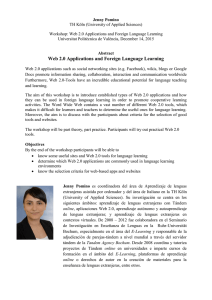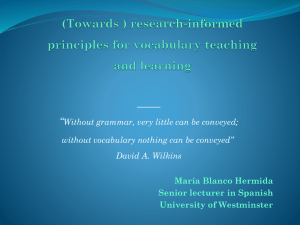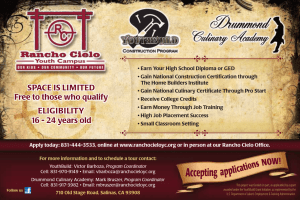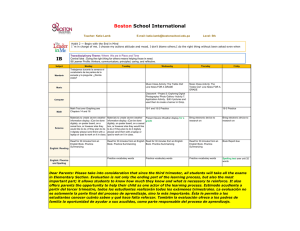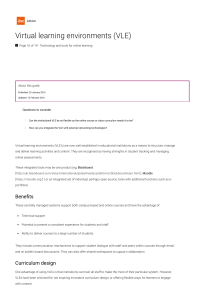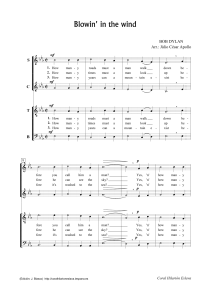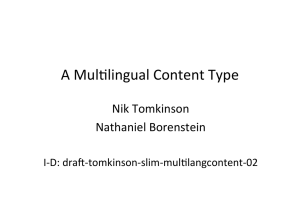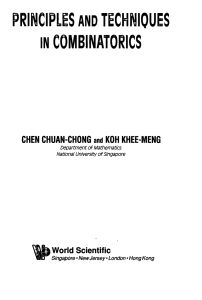Construction of the Foundations of the PLE and PLN for
Anuncio
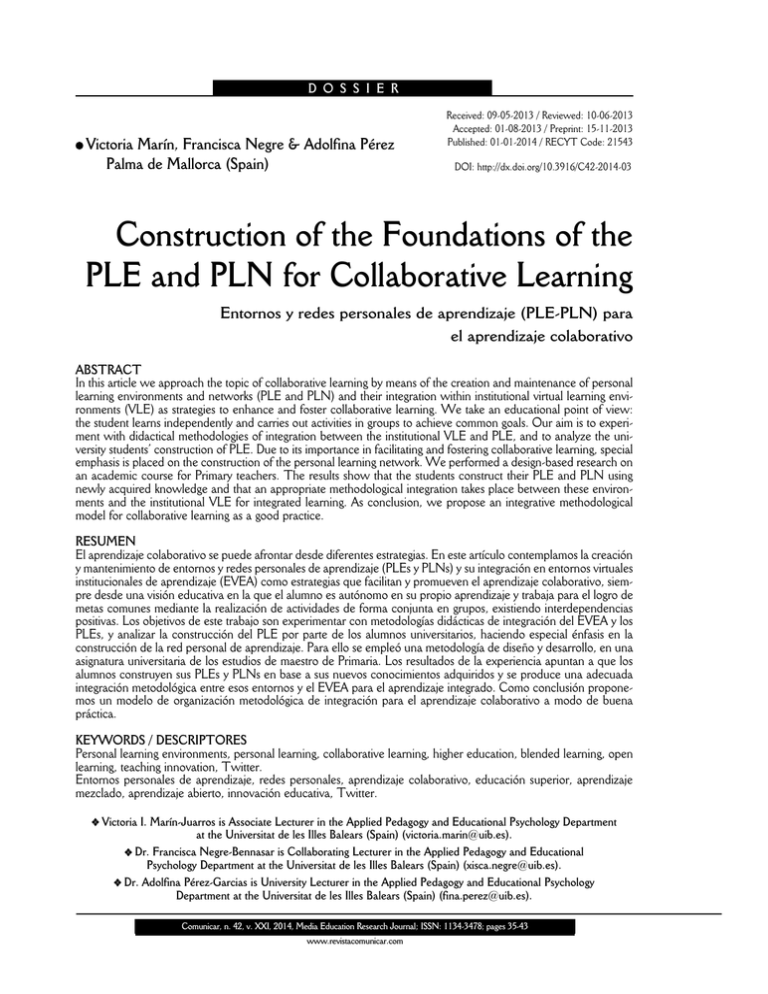
D O S S I E R Marín, Francisca Negre & Adolfina Pérez Palma de Mallorca (Spain) l Victoria Received: 09-05-2013 / Reviewed: 10-06-2013 Accepted: 01-08-2013 / Preprint: 15-11-2013 Published: 01-01-2014 / RECYT Code: 21543 DOI: http://dx.doi.org/10.3916/C42-2014-03 Construction of the Foundations of the PLE and PLN for Collaborative Learning Entornos y redes personales de aprendizaje (PLE-PLN) para el aprendizaje colaborativo ABSTRACT In this article we approach the topic of collaborative learning by means of the creation and maintenance of personal learning environments and networks (PLE and PLN) and their integration within institutional virtual learning environments (VLE) as strategies to enhance and foster collaborative learning. We take an educational point of view: the student learns independently and carries out activities in groups to achieve common goals. Our aim is to experiment with didactical methodologies of integration between the institutional VLE and PLE, and to analyze the university students’ construction of PLE. Due to its importance in facilitating and fostering collaborative learning, special emphasis is placed on the construction of the personal learning network. We performed a design-based research on an academic course for Primary teachers. The results show that the students construct their PLE and PLN using newly acquired knowledge and that an appropriate methodological integration takes place between these environments and the institutional VLE for integrated learning. As conclusion, we propose an integrative methodological model for collaborative learning as a good practice. RESUMEN El aprendizaje colaborativo se puede afrontar desde diferentes estrategias. En este artículo contemplamos la creación y mantenimiento de entornos y redes personales de aprendizaje (PLEs y PLNs) y su integración en entornos virtuales institucionales de aprendizaje (EVEA) como estrategias que facilitan y promueven el aprendizaje colaborativo, siempre desde una visión educativa en la que el alumno es autónomo en su propio aprendizaje y trabaja para el logro de metas comunes mediante la realización de actividades de forma conjunta en grupos, existiendo interdependencias positivas. Los objetivos de este trabajo son experimentar con metodologías didácticas de integración del EVEA y los PLEs, y analizar la construcción del PLE por parte de los alumnos universitarios, haciendo especial énfasis en la construcción de la red personal de aprendizaje. Para ello se empleó una metodología de diseño y desarrollo, en una asignatura universitaria de los estudios de maestro de Primaria. Los resultados de la experiencia apuntan a que los alumnos construyen sus PLEs y PLNs en base a sus nuevos conocimientos adquiridos y se produce una adecuada integración metodológica entre esos entornos y el EVEA para el aprendizaje integrado. Como conclusión proponemos un modelo de organización metodológica de integración para el aprendizaje colaborativo a modo de buena práctica. KEYWORDS / DESCRIPTORES Personal learning environments, personal learning, collaborative learning, higher education, blended learning, open learning, teaching innovation, Twitter. Entornos personales de aprendizaje, redes personales, aprendizaje colaborativo, educación superior, aprendizaje mezclado, aprendizaje abierto, innovación educativa, Twitter. v Victoria I. Marín-Juarros is Associate Lecturer in the Applied Pedagogy and Educational Psychology Department at the Universitat de les Illes Balears (Spain) (victoria.marin@uib.es). v Dr. Francisca Negre-Bennasar is Collaborating Lecturer in the Applied Pedagogy and Educational Psychology Department at the Universitat de les Illes Balears (Spain) (xisca.negre@uib.es). v Dr. Adolfina Pérez-Garcias is University Lecturer in the Applied Pedagogy and Educational Psychology Department at the Universitat de les Illes Balears (Spain) (fina.perez@uib.es). Comunicar, n. 42, v. XXI, 2014, Media Education Research Journal; ISSN: 1134-3478; pages 35-43 www.revistacomunicar.com Comunicar, 42, XXI, 2014 36 1. Introduction The university of the future should be an institution that provides education to a greater part of the population throughout their lives and which generates knowledge that is of service to educational needs (Salinas, 2012). This has led to the setting-up of various learning scenarios that are currently being tried and researched. These learning scenarios are being developed within the concept of Personal Learning Environments (PLE) and open learning environments (Brown, 2010; Hannafin, Land & Oliver, 1999; Sclater, 2008). The concept of PLE is defined, from a pedagogical point of view, as the set of tools, materials and human resources that a person is aware of and uses for life-long learning (Adell & Castañeda, 2010; Attwell, 2007; Hilzensauer & Schaffert, 2008). The functions of the PLE that we took into account in this work, as indicated by Wheeler (2009) are: information management (related to personal knowledge management), creation of content and connections with others (which is known as the personal learning or knowledge network). PLE involve a change in education in favour of student-centred learning by overcoming the limitations of virtual learning/teaching environments (VLE) based on learning management systems (LMS). PLE, therefore, enable students to take control and manage their own learning, taking into account decisions on their personal learning goals, management of their own learning (content and process management), communication with others in the learning process and everything else that contributes to achieving their goals (Salinas, 2013). We started on the basis of the theory known as LaaN, Learning as a Network, which includes various concepts and theories, such as connectivism (learning as a connection), the complexity theory (understanding the dynamics and uncertainty of knowledge in current society), the concept of double loop learning (learning about errors and research) and, in particular, knowledge environments (Chatti, Schroeder & Jarke, 2013; Chatti 2013), considering that «learning is the continuous creation of a personal knowledge network» (Adell & Castañeda, 2013:38). This Personal Learning Network (PLN or PKN) consists of the sum of connections with other people’s PLE (their tools and strategies for reading, reflection and relationships), that make up knowledge environments (Chatti et al., 2012) and whose interaction produces the development and enabling of strategies for the actual PLE and, therefore, are central to learning and professional development (Couros, 2010; Downes, 2010; Sloep & Berlanga, 2011). The idea of the PLN is that each person contributes their knowledge so that what is most important is not what each person has in their PLE, but the sharing of those resources. The LaaN theory is «an attempt to draw up a theoretical foundation for learning and teaching which will start up the construction and enrichment of the actual PLE» (Adell & Castañeda, 2013: 38). In addition, PLE can also be used as bases for constructive learning (Adell & Castañeda, 2013), given that they are able to comply with the five features for activities leading to significant learning proposed by Jonassen et al. (2003), they are active, constructive, intentional, authentic and collaborative. A collaborative environment (CSCL, Computer Supported Collaborative Learning) is based on group work that begins with interaction and collaboration (Johnson & Johnson, 1996; Lipponen, 2002), provides communication tools and makes human resources from various fields available (teachers, experts, colleagues, etc.). Collaboration as a learning strategy is based on working in heterogeneous groups of people with similar knowledge levels to achieve communal goals and carry out tasks together, with there being a positive interdependence between them (Dillenbourg, 1999; Prendes, 2007). There is no single correct answer in collaborative tasks. Instead, there are several ways of arriving at the result and, to achieve this, students must share and reach agreements, an event that helps them to be socially and intellectually more selfsufficient and mature (Bruffee, 1995). This study is framed within a wider research project that seeks to define and test various didactic strategies for the integration of PLE and VLE taking into account different learning environments (formal, informal and casual) on the basis of previous works (Marín, 2013; Marín & Salinas, in press; Marín, Salinas & de Benito, 2012, 2013; Salinas, Marín & Escandell, in press). In this article, on the basis of these ideas, we present an experiment in which methodologies that seek to encourage collaboration and integration of these environments within the university (PLE and PLN on the one hand, and VLE on the other) are put into practice, as well as some of the results observed during the process. 2. Methodology for the study The study was carried out on a group of teachers and students on the course «Technological media and resources for primary education» in the third year of © ISSN: 1134-3478 • e-ISSN: 1988-3293 • Pages 35-43 studies for the Primary Teacher’s Degree at the tion spaces and the development of the PLE enables University of the Balearic Islands. The material is development of information management processes worth 6 ECTS points and the intention is to develop and participation in external learning networks. skills in the use of technology that will enable teaching The elements of the strategy shown in figure 1, and learning processes at school. based on course tasks and some features of collaboraThe course group was made up of three teachers tive learning are set out below. and 192 students organised into three large groups of • Access course study guides. Content is presented approximately 70 and ten practical groups of approxistructured into concept maps that represent and intermately 25. connect basic concepts and provide supplementary All the students had prior knowledge of technoloresources (reading, videos, examples, etc). Hints are gical tools given that they had studied a course relating given for development of the work project and practical to education technology during the first year activities. These materials are provided by the teachers (Information and Communication Technologies and are available on the Moodle-based VLE. applied to Primary Education). • Locate, access and organise supplementary According to an initial questionnaire, answered by materials using generic search engines (eg, Google), 179 students, it can be seen that the majority are social bookmarking (eg, delicious), specific search women (71%), are under 24 years old (70%) and are engines (eg, Google Scholar), content recovery (eg, frequent users of social networks (mainly Facebook), materials published/shared on Twitter by one person generic search engines (Google) and video web sites or another). Students are encouraged to find useful (Youtube). This creates an internet user profile that is information to carry out course activities and organise basically that of a consumer – they consume informainformation organisation systems. tion and communicate with their friends but hardly • Personally organise and manage information ever produce content. (using personal organisation tools, RSS subscription to The development of the course was based on blogs/web sites, following in Twitter, use of Symbalearning principles centred on student and methodololooEDU to organise new information). Furthermore, gies focusing on collaboration and social construction within the framework of the course, the student is of knowledge (Salinas, Pérez & de Benito, 2008). It offered shared resources and links (paper.li). was structured around the following activities, relating Activities related to creating content: to the development of the student’s PLE, according to • Organise the PLE itself using SymbalooEDU, in the basic functions indicated by Wheeler (2009): a) which each student organises the tools and resources development of a design and development-based work group project; b) creation of personal learning networks; and c) use of appropriate internet technology to locate and manage information, create content and share knowledge. In addition, a methodological strategy was organised that would allow integration of the use of the PLE into the VLE, in which the VLE offers access to basic documentation on the course and large group Figure 1. Methodological strategy for integration of the VLE and PLE into the course. or private communica© ISSN: 1134-3478 • e-ISSN: 1988-3293 • Pages 35-43 Comunicar, 42, XXI, 2014 37 Comunicar, 42, XXI, 2014 38 that they use to carry out the course tasks and other environments. • Create a personal blog that gives an account of the learning activities carried out during the course. Entries include materials developed by students in different formats (text, audio, video, texting, interactive multimedia, etc) and reflections on teaching practice. • Develop and publish a collaborative group project that requires the creation of didactic materials for primary education (interactive multimedia, video and WebQuest). This project follows the features of collaborative learning according to Johnson, Johnson & Holubec (1999) – existence of positive interdependence, individual and group responsibility, stimulating interaction, availability of the necessary personal and group attitudes and abilities, and group assessment. The project is delivered through the VLE. Finally, in relation to connection with others, the following activities are included: • Interaction and collaboration with others through the VLE in relation to the activities proposed in forums (debates) or via private messaging to the teacher or other students. These activities are in line with the features indicated by Onrubia (1997) for collaborative learning – they are group tasks, require contribution by everyone and have sufficient resources to be completed. • Share and circulate the results of activities using the personal blog and sending messages on Twitter, using the hashtags set up for the course (chat on Twitter), to other people and/or colleagues to circulate their work on the blog and share interesting resources, encouraging interaction, participation and communication (Ingram & Hathorn, 2004). • Communicate and collaborate on educational virtual communities and social networks or others of interest (outside the course hashtag on Twitter). • Widen their personal learning network (PLN) by following people of interest, on Twitter as well as other social networks or virtual communities or via RSS subscriptions, with teachers, experts and people related to field of interest, etc. 2.1. Tools for information collection The tools for information collection are qualitative as well as quantitative with the aim of enabling interpretation and relevance of the information. The tools are as follows: • Analysis of documents relating to integration of the PLE elements. These documents are amongst those produced by the students during the course. On the one hand, group projects and personal blog entries, and on the other, the evolution of the PLE’s construction, represented graphically by screen shots of their SymbalooEDU. • Observation of the student’s reaction in relation to implementation of didactic integration with respect to the personal learning network. This is done by carrying out a non-exhaustive descriptive and quantitative analysis of interactions on Twitter. The number of log-ons, comments between students, following people inside and outside the course, interactions aimed at sharing resources and activities, etc, are taken into account. A descriptive observation of the dynamic of the PLN in the blogs is also reviewed. 2.2. Study stages The experience is carried out in four stages, following the methodology of design and development (Reeves, 2000; 2006; Van-den-Akker, 1999): • Stage 1. Analysis of the situation and definition of the problem. Precedent research on techno-educational integration of PLE and VLE is reviewed. This is defined as the need to improve and optimise teaching/learning processes with the aim of integrating all fields of learning and centre on strategies that focus on the student’s learning. • Stage 2. Development of solutions. Together with the teacher in charge of the course, a methodological strategy for didactic integration of the PLE and VLE is designed, which has previously been described. The elements of the strategy that are the least known are worked on with the teachers. • Stage 3. Implementation and assessment. This stage puts into practice the strategy designed for the course, while at the same time the process is followed up and changes for iterative improvement are made to the strategy (eg, technical difficulties in the use of paper.li and Twitter meant proposing the use of other tools). At the start of the course a PLE workshop is held with students and they are asked to put the SymbalooEDU screen shots representing their PLE on their blogs at the start and end of the course. Periodically, entries on personal blogs are collected and SymbalooEDU screen shots on the blogs are saved after following RSS. A content analysis is made of the screen shots by counting the number of blocks included and according to type in accordance with the three PLE functions. A descriptive analysis is made on the selection and inclusion of tools from the group projects, included in the VLE, and blog entries. Furthermore, tweets made with the course’s hashtag are also collected using an automatic tweet collector system (Rowfeeder). Afterwards, a content analysis © ISSN: 1134-3478 • e-ISSN: 1988-3293 • Pages 35-43 is carried out using the tweet count and they are coded according to type. Later interaction on the blog of the people identified as most active on Twitter is examined, reviewing the comments on their blogs. • Stage 4. Document production and design principles. Assessment of the strategy using the data collected leads to the proposal for a didactic integration model for the student’s PLE and the VLE. 3. Results 3.1. PLE construction With respect to students’ evolution in the PLE, the following table shows the main statistics to be taken into account for SymbalooEDU screen shots and the level of participation at the start and end of the course. used at the start and finish of the course, in spite of the fact that some remain the same. With respect to information management resources, a highlight is the use of tools relating to locating relevant information for developing the course project, such as news links (many of which were related to the application of technology in education), learning banks (eg, educational activities) and search engines. We can see an increase in the first two. Some students included SymbalooEDU on their home pages as tools for personal organisation. This is interesting because information organisation and management is one of the PLE’s aims. The greatest increase is seen in content generation tools. Given that the course mainly worked on educational content generation for primary education, many students included applications in their PLE that they considered useful for that purpose. Among the blocks included, highlights were collaborative creation and interactive exercise creation tools, blogs, web site creation, audio, image creation, walls, comics and videos. A wide variety of tools can be seen within each category, although the most frequently used are small in number. At the start of the course, the most frequently used content generation tools were blogs (Blogger) and collaborative work tools (Google Drive). At the end of the course, these tools were still commonly used as they continue to be used during the course and were found to be useful, but there is also evidence of an increase in other content generation tools, as indicated above. The image given by this count gives us an idea about the type of tools used by the students at the beginning and end of the course on their PLE, whether they used them, or considered them interesting for use now or in the not too distant future. The evolution of the percentage number of blocks per resource type is shown below. In spite of the fact that the evolution of the number of blocks per type of tool does not undergo serious changes (the most significant is the increase from 20% to 28% in blocks referring to content generation tools), a significant increase in the number of resources included at the start (101) and end (144) taking into account the various types can be seen. Looking at each type, as more specific statistics, notable differences can Figure 2. Percentage amount of information management resource blocks at the start be seen between the tools and links and end of the course. © ISSN: 1134-3478 • e-ISSN: 1988-3293 • Pages 35-43 Comunicar, 42, XXI, 2014 39 Comunicar, 42, XXI, 2014 40 • 1451 tweets (73%) shared the results of course activities with other the other students, as was indicated in the initial instructions for the course. • 190 tweets (10%) shared resources of interest to the rest of the course group. This content was related to that being worked on in class. 37 of these 190 tweets produced interaction with people outside the course (teachers, educational organisations, etc) by retweets or citations. • 182 tweets (9%) were informal communications, with these consiFigure 3. Percentage amount of blocks content generation tools at the start and dered to be messages to the whole end of the course. group (greetings) and comments or dialogue with other students about Finally, social networks and asynchronous comthe course (asking for help, questions, etc.). munication tools stand out in relation to communica• 163 tweets (8%) were recorded relating to inting with others. An increase in the tools needed to teraction between students: retweets to colleagues or share course activities on the blog can be seen (eg, comments on jointly written blog entries, the group tools for sharing files, videos, visual presentations, text project, etc. documents, etc.). It can also be seen that in the cateIn addition, the number of followers and followed gory of generic social networks, compared to the start, was reviewed. It turned out that the average number there was a majority inclusion of the students’ PLE on of followers for each student was 38.38 and followed, Twitter. 61.39. Regarding those followed, out of the 189 students who took part on Twitter with their group’s 3.2. Development of the PLN hashtag for the course, 82 started to follow people/Regarding the development of the personal learorganisations outside the course. Therefore, in many ning network, the use of Twitter by students was cases, students enriched their use of the social network mainly taken into account. A total of 1986 tweets using by going further than the formal environment, and parthe hashtags set up were counted, without taking into ticularly into the informal. account repeats. In total, 189 of the students in the Based on the percentage of non-obligatory particithree groups took part, 47 of whom already had an account on that social network. The average number of tweets per person was 10.51 (the minimum was 1 and the maximum 112), the trend was 10 and the density was low (0.11), as the greater number of interactions came from just a few authors. These were those configured as «group leaders». These people were significant as they acted as the catalyst for the group on the social network and encouraged participation by other colleagues. The 1986 tweets were divided up according to their use. The results can be Figure 4. Percentage amount of blocks of interconnection tools at the start and end of the course. seen below: © ISSN: 1134-3478 • e-ISSN: 1988-3293 • Pages 35-43 pation (interactions not directed at sharing the blog) (average: 2.83), those taking part with more than 5 tweets were taken into account. Those who went over this number were discounted if their interactions were the type citing joint work in blog entries (tweets not aimed at boosting the social space). In this way, a total of 13 people were counted, 9 students from the first group, 2 from the second group and 1 from the third group. In addition, the dynamic of each group on Twitter was different. The active students in the first group, and to a lesser extent in the third group, aimed to share resources and comment on them, while the second group was more of an informal help space. In this case, it was seen that the students’ PLN was created around the blogs, as one of them acted as mentor and the others followed and were supported by the mentor’s explanations. On the other hand, no significant interaction was noticed between the groups. 4. Discussion and conclusions Throughout the course the VLE was the bridge between the student’s PLE and the educational institution. It was used, above all, as an initial portal although almost all the learning process was developed using external elements that made up or became part of the student’s PLE (blogs, Twitter, etc). In addition, the VLE was didactically integrated into the student’s PLE naturally. Furthermore, the evolution in the student’s construction of the PLE and PLN was confirmed. They developed procedures based on locating and managing information that would be useful for solving problems, creating content and communicating with the others. During this process well-known tools were used and new ones were continuously selected. Tools used in other environments were integrated and the spaces created within the framework of the course were extrapolated to other contexts. During this evolution in management of the actual learning process, the students experienced the passage from being passive consumers of information and resources to being creators of content and materials in a variety of formats (Hilzensauer & Schaffert, 2008). This variety responds to the methodological strategy for the course that promotes content creation while at the same time giving independence so that it is the student –or group– who chooses the tools that are the most appropriate for the needs of the activity and its features. Furthermore, foundations have been laid for the creation of personal learning networks in as much as © ISSN: 1134-3478 • e-ISSN: 1988-3293 • Pages 35-43 Comunicar, 42, XXI, 2014 41 Figure 5. Percentage of tweets according to use. the students have learned to take part in social networks, organise a social learning network, and participate in a sharing culture. Nevertheless, it is still necessary to overcome some challenges such as the level of participation and the degree of involvement in order to develop a truly collaborative process based on interaction and communication (Kirschner, 2002). What has been seen were various types of networks but confined to the group for the course with occasional external, support-based interaction, distribution of filtered resources and redistribution of contributions, whether their own or from others. The impact of the experience on students’ learning arising from implementing the strategy was assessed as positive, as it promotes the student’s independence while learning, as well as collaborative knowledge construction based on the development of the group project and networks constructed around the course. These learning networks have huge potential that should be valued as a strategy for methodological change towards meaningful ways of learning based on problem solving or project development. This experience enabled the development and evaluation of social knowledge construction processes, encouraging the student: a) to search for information, identify problems, acquire filtering criteria, interconnect and locate relevant data and distribute useful information; b) acknowledge and express their personal viewpoint (ideas and progress); and c) share this with the group and be able to change their point of view, adopt new perspectives, clarify points of disagreement, debate, negotiate agreements (Bruffee, 1995) and, finally, formulate and present knowledge (Stahl, 2000). Therefore, we propose a methodological organisation model as good practice for collaborative learning, with a suggested tool for each element in brackets. The PLE, as the central element, includes the spaces and processes marked out for its uses (Wheeler, Comunicar, 42, XXI, 2014 42 2009): content creation, whether individual (e-portfolio, tool selection) or group (using collaborative work and communication tools), information management (individual and collaborative selection and recommendation of resources) and connection with others (using an open space for social communication and collaboration to create learning comFigure 6. Proposed model for methodological organisation of integration for collaborative learning. munities for collaborative knowledge construction). Web 2.0 for learning and teaching. Interactive Learning Environments, 18 (1), 1-10. (DOI: http://dx.doi.org/10.1080/104948208Compared to the initial model, the proposed chan02158983). ges to tools with respect to the technical difficulties BRUFFEE, K. (1995). Sharing our toys - Cooperative learning versus with Twitter and paper.li are included: introduction of collaborative learning. Change, 27 ≠(1), 12-18. (DOI: http://dx.doi.content aggregation systems (Scoop.it, Twubs) for org/10.1080/00091383.1995.9937722). better information and PLN management and the CHATTI, M.A. (2013). The LaaN Theory. In S. DOWNES, G. SIEMENS & R. KOP (Eds.), Personal learning environments, networks, tools that are the subject of this course (generation of and knowledge. (www.elearn.rwth-aachen.de/dl1151|Mohaeducational materials for primary education). Acknowledgments This work is framed within the research project EDU2011-25499 «Methodological strategies for integrating institutional virtual environments, personal and social learning», developed by the Educational Technology Group (GTE) of the University of the Balearic Islands since 2012 and funded by the Ministry of Education and Science of Spain, within the National Programme for Fundamental Research. References ADELL, J. & CASTAÑEDA, L. (2010). Los Entornos Personales de Aprendizaje (PLEs): una nueva manera de entender el aprendizaje. In R. ROIG VILA & M. FIORUCCI (Eds.), Claves para la investigación en innovación y calidad educativas. La integración de las tecnologías de la información y la comunicación y la interculturalidad en las aulas. (pp. 19-30). Alcoy: Marfil / Roma TRE Università degli Studi. (http://hdl.handle.net/10201/17247) (10-05-2013). ADELL, J. & CASTAÑEDA, L. (2013). El ecosistema pedagógico de los PLEs. In L. CASTAÑEDA & J. ADELL (Eds.), Entornos Personales de Aprendizaje: Claves para el ecosistema educativo en Red. (pp. 29-51). Alcoy: Marfil. (http://digitum.um.es/xmlui/bitstream/10201/30409/1/capitulo2.pdf) (10-07-2013). ATTWELL, G. (2007). Personal learning environments - the future of eLearning? In eLearning Papers, 2 (1), 1-8. (www.elearningeuropa.info/files/media/media11561.pdf) (10-05-2013). BROWN, S. (2010). From VLEs to learning webs: the implications of med_Chatti_LaaN_preprint.pdf) (07-05-2013). CHATTI, M.A., SCHROEDER, U. & JARKE, M. (2012). LaaN: Convergence of Knowledge Management and Technology-enhanced Learning. IEEE Transactions on Learning Technologies, 5 (2), 177-189. (DOI: http://doi.ieeecomputersociety.org/10.1109/TLT.2011.33). COUROS, A. (2010). Developing Personal Learning Networks for Open and Social Learning. In G. VELETSIANOS (Ed.), Emerging Technologies in Distance Education. (pp. 109-128). Canada: AU Press, Athabasca University. DILLENBOURG, P. (1999). Collaborative Learning Cognitive and computational Approaches Advances in learning and instructional series. Oxford (UK): Pierre Pergamon. DOWNES, S. (2010). Learning Networks and Connective Knowledge. Collective Intelligence and ELearning 20 Implications of Web Based Communities and Networking. (pp. 1-26). IGI Publishing. (http://dx.doi.org/10.4018/978-1-60566-729-4.ch001). HANNAFIN, M.J. LAND, S. & OLIVER, K. (1999). Open Learning Environments: Foundations, Methods and Models. In C.M. REIGELUTH (Ed.), Instructional-Design Theories and Models. A New Paradigm of Instructional Theory. (Volume II, pp. 115-140). Mahwah (NJ): Lawrence Erlbaum Associates, Inc. HILZENSAUER, W. & SCHAFFERT, S. (2008). On the way towards Personal Learning Environments: Seven crucial aspects. In Elearning Papers, 9. (www.elearningeuropa.info/files/media/media15971.pdf) (10-05-2013). INGRAM, A. & HATHORN L. (2004). Methods for analyzing collaboration in online communications. In T. ROBERTS (Ed), Online Collaborative Learning: Theory and Practice. (pp. 215-241). Her© ISSN: 1134-3478 • e-ISSN: 1988-3293 • Pages 35-43 shey, PA: Idea Group Publishing. (http://dx.doi.org/10.4018/978-159140-174-2.ch010). JOHNSON, D. & JOHNSON, R. (1996). Cooperation and the Use of Technology. In M.J. SPECTOR, D.M. MERRILL, J. VAN-MERRIENBOER & M.P. DRISCOLL (Eds.), Handbook of Research for Educational Communications and Technology. (vol. 1, pp. 785-812). New York: Routledge. JOHNSON, D., JOHNSON, J. & HOLUBEC, E. (1999). El aprendizaje cooperativo en el aula. Buenos Aires: Paidós. JONASSEN, D.H., HOWLAND, J.L., MOORE, J.L. & MARRA, R.M. (2003). Learning to Solve Problems with Technology: A Constructivist Perspective. Upper Saddle River (New Jersey): Merrill Prentice Hall. KIRSCHNER, P.A. (2002). Can we support CSCL? Educational, Social and Technological Affordances for Learning. In P.A. KIRSCHNER (Ed.), Three Worlds of CSCL: Can We Support CSCL? (pp. 7-47). Heerlen (The Netherlands): Open University of the Netherlands. (http://hdl.handle.net/1820/1618) (17-08-2013). LIPPONEN, L. (2002). Exploring Foundations for Computer-supported Collaborative Learning, CSCL ‘02 Proceedings of the Conference on Computer Support for Collaborative Learning: Foundations for a CSCL Community. (pp. 72-81). (http://dl.acm.org/citation.cfm?id=1658627) (17-08-2013). MARÍN, V.I. (2013). Estrategias metodológicas para el uso de espacios compartidos de conocimiento. In L. CASTAÑEDA Y J. ADELL (Eds.), Entornos personales de aprendizaje: Claves para el ecosistema educativo en Red. (pp. 143-149). Alcoy: Marfil. (http://digitum.um.es/xmlui/bitstream/10201/30419/1/capitulo81.pdf) (10-07-2013). MARÍN, V.I. & SALINAS, J. (in press). First Steps in the Development of a Model for Integrating Formal and Informal Learning in Virtual Environments. In LEONE, S. (Ed.), Synergic Integration of Formal and Informal E-Learning Environments for Adult Lifelong Learners. Hershey (PA, USA): IGI Global. (DOI: 10.4018/978-1-4666-4655-1). MARÍN, V.I., SALINAS, J. & DE-BENITO, B. (2013). Research Results of Two Personal Learning Environments Experiments in a Higher Education Institution. Interactive Learning Environments (Special Issue: LMS – Evolving from Silos to Structures). (DOI: www.tandfonline.com/doi/abs/10.1080/10494820.2013.788031). MARÍN, V.I., SALINAS, J. & DE BENITO, B. (2012). Using SymbalooEDU as a PLE Organizer in Higher Education. Proceedings of the PLE Conference 2012. Aveiro, Portugal. (http://revistas.ua.pt/index.php/ple/article/view/1427) (10-05-2013). ONRUBIA, J. (1997). Escenarios cooperativos. Cuadernos de Pedagogía, 255, 65-70. PRENDES, M.P. (2007). Internet aplicado a la educación: estrategias didácticas y metodologías. In CABERO, J. (Coord.), Nuevas tecnologías © ISSN: 1134-3478 • e-ISSN: 1988-3293 • Pages 35-43 aplicadas a la educación. (pp. 205-222). Madrid: McGraw-Hill. REEVES, T.C. (2006). Design research from the technology perspective. In J. VAN-DEN-AKKER, K. GRAVEMEIJER, S. MCKENNEY & N. NIEVEEN (Eds.), Educational Design Research. (pp. 86-109). London: Routledge. REEVES, T.C. (2000). Enhancing the Worth of Instructional Technology Research through «Design Experiments» and Other Development Research Strategies. International Perspectives on Instructional Technology Research for the 21st Century Symposium. New Orleans, LA, USA. SALINAS, J., MARÍN, V.I. & ESCANDELL, C. (in press). Exploring the Possibilities of an Institutional PLE in higher education: Integration of a VLE and an E-Portfolios System. International Journal of Virtual and Personal Learning Environments. SALINAS, J. (2012). La investigación ante los desafíos de los escenarios de aprendizaje futuros. Red, 32. (www.um.es/ead/red/32) (0705-2013). SALINAS, J. (2013). Enseñanza flexible y aprendizaje abierto. Fundamentos clave de los PLEs. In L. CASTAÑEDA & J. ADELL (Eds.), Entornos personales de aprendizaje: Claves para el ecosistema educativo en Red. (pp. 53-70). Alcoy: Marfil. (http://digitum.um.es/jspui/bitstream/10201/30410/1/capitulo3.pdf) (10.7.2013) SALINAS, J., PÉREZ, A. & DE BENITO, B. (2008). Metodologías centradas en el alumno para el aprendizaje en Red. Madrid: Síntesis. SCLATER, N. (2008). Web 2.0. Personal Learning Environments, and the Future of Learning Management Systems. Educause Center for Applied Research - Research Bulletin, 2008 (13). (www.educause.edu/library/resources/web-20-personal-learning-environmentsand-future-learning-management-systems) (10-05-2013). SLOEP, P. & BERLANGA, A. (2011). Redes de aprendizaje, aprendizaje en Red. Comunicar, 37, 55-64. (DOI: http://dx.doi.org/10.3916/C37-2011-02-05). STAHL, G. (2000). A Model of Collaborative Knowledge-Building. In B. FISHMAN & S. O’CONNOR-DIVELBISS (Eds.), Fourth International Conference of the Learning Sciences. (pp. 70-77). Mahwah, NJ: Erlbaum. (http://citeseerx.ist.psu.edu/viewdoc/download?doi=10.1.1.97.8816&rep=rep1&type=pdf) (10-05-2013). VAN-DEN-AKKER, J. (1999). Principles and Methods of Development Research. In J. VAN DEN AKKER, R.M. BRANCH, K. GUSTAFSON, N. NIEVEEN & T. PLOMP (Eds.), Design Approaches and Tools in Education and Training. (pp. 1-14). Dordretch (The Netherlands): Kluwer Academic Publishers. WHEELER, S. (2009). It’s Personal: Learning Spaces, Learning Webs. Blog entry in Learning with with ‘e’s. (http://steve-wheeler.blogs pot.com.es/2009/10/its-personal-learning-spaces-learn ing.html) (07-05-2013). Comunicar, 42, XXI, 2014 43
